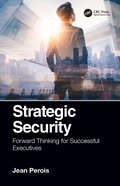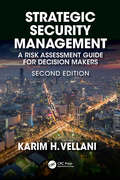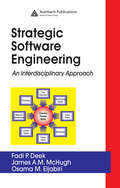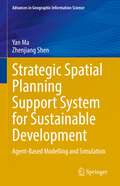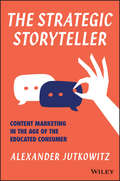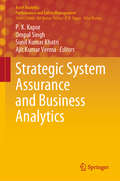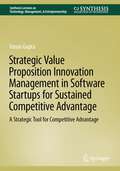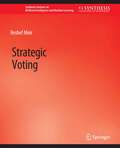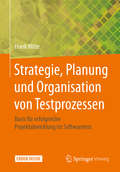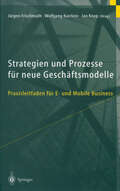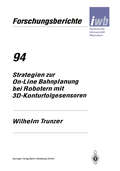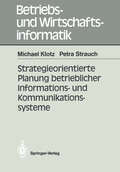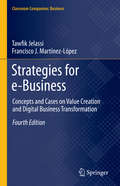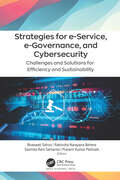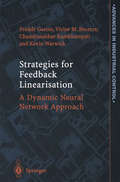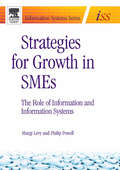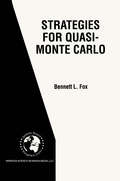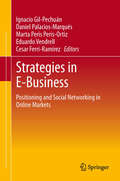- Table View
- List View
Strategic Security: Forward Thinking for Successful Executives
by Jean PeroisStrategic Security will help security managers, and those aspiring to the position, to think strategically about their job, the culture of their workplace, and the nature of security planning and implementation. Security professionals tend to focus on the immediate (the urgent) rather than the important and essential—too often serving as "firefighters" rather than strategists. This book will help professionals consider their roles, and structure their tasks through a strategic approach without neglecting their career objectives. Few security management books for professionals in the field focus on corporate or industrial security from a strategic perspective. Books on the market normally provide "recipes," methods or guidelines to develop, plans, policies or procedures. However, many do so without taking into account the personal element that is supposed to apply these methods. In this book, the authors helps readers to consider their own career development in parallel with establishing their organisation security programme. This is fundamental to becoming, and serving as, a quality, effective manager. The element of considering career objectives as part-and-parcel to this is both unique to only this book and vital for long-term career success. The author delineates what makes strategic thinking different in a corporate and security environment. While strategy is crucial in the running of a company, the traditional attitude towards security is that it has to fix issues quickly and at low cost. This is an attitude that no other department would tolerate, but because of its image, security departments sometimes have major issues with buy-in and from top-management. The book covers the necessary level of strategic thinking to put their ideas into practice. Once this is achieved, the strategic process is explained, including the need to build the different steps into this process—and into the overarching business goals of the organisation—will be demonstrated. The book provides numerous hand-on examples of how to formulate and execute the strategic master plan for the organization. The authors draws on his extensive experience and successes to serve as a valuable resource to all security professionals looking to advance their careers in the field.
Strategic Security: Forward Thinking for Successful Executives
by Jean PeroisStrategic Security will help security managers, and those aspiring to the position, to think strategically about their job, the culture of their workplace, and the nature of security planning and implementation. Security professionals tend to focus on the immediate (the urgent) rather than the important and essential—too often serving as "firefighters" rather than strategists. This book will help professionals consider their roles, and structure their tasks through a strategic approach without neglecting their career objectives. Few security management books for professionals in the field focus on corporate or industrial security from a strategic perspective. Books on the market normally provide "recipes," methods or guidelines to develop, plans, policies or procedures. However, many do so without taking into account the personal element that is supposed to apply these methods. In this book, the authors helps readers to consider their own career development in parallel with establishing their organisation security programme. This is fundamental to becoming, and serving as, a quality, effective manager. The element of considering career objectives as part-and-parcel to this is both unique to only this book and vital for long-term career success. The author delineates what makes strategic thinking different in a corporate and security environment. While strategy is crucial in the running of a company, the traditional attitude towards security is that it has to fix issues quickly and at low cost. This is an attitude that no other department would tolerate, but because of its image, security departments sometimes have major issues with buy-in and from top-management. The book covers the necessary level of strategic thinking to put their ideas into practice. Once this is achieved, the strategic process is explained, including the need to build the different steps into this process—and into the overarching business goals of the organisation—will be demonstrated. The book provides numerous hand-on examples of how to formulate and execute the strategic master plan for the organization. The authors draws on his extensive experience and successes to serve as a valuable resource to all security professionals looking to advance their careers in the field.
Strategic Security Management: A Risk Assessment Guide for Decision Makers, Second Edition
by Karim VellaniStrategic Security Management, Second Edition provides security leadership and decision-makers with a fresh perspective on threat, vulnerability, and risk assessment. The book offers a framework to look at applying security analysis and theory into practice for effective security program, implementation, management and evaluation. Chapters examine metric-based security resource allocation of countermeasures, including security procedures, utilization of personnel, and electronic measures. The new edition is fully updated to reflect the latest industry best-practices and includes contributions from security industry leaders—based on their years of professional experience—including: Nick Vellani, Michael Silva, Kenneth Wheatley, Robert Emery, Michael Haggard. Strategic Security Management, Second Edition will be a welcome addition to the security literature for all security professionals, security managers, and criminal justice students interested in understanding foundational security principles and their application.
Strategic Security Management: A Risk Assessment Guide for Decision Makers, Second Edition
by Karim VellaniStrategic Security Management, Second Edition provides security leadership and decision-makers with a fresh perspective on threat, vulnerability, and risk assessment. The book offers a framework to look at applying security analysis and theory into practice for effective security program, implementation, management and evaluation. Chapters examine metric-based security resource allocation of countermeasures, including security procedures, utilization of personnel, and electronic measures. The new edition is fully updated to reflect the latest industry best-practices and includes contributions from security industry leaders—based on their years of professional experience—including: Nick Vellani, Michael Silva, Kenneth Wheatley, Robert Emery, Michael Haggard. Strategic Security Management, Second Edition will be a welcome addition to the security literature for all security professionals, security managers, and criminal justice students interested in understanding foundational security principles and their application.
Strategic Software Engineering: An Interdisciplinary Approach
by Fadi P. Deek James A. McHugh Osama M. EljabiriThe pervasiveness of software in business makes it crucial that software engineers and developers understand how software development impacts an entire organization. Strategic Software Engineering: An Interdisciplinary Approach presents software engineering as a strategic, business-oriented, interdisciplinary endeavor, rather than simply a technica
Strategic Spatial Planning Support System for Sustainable Development: Agent-Based Modelling and Simulation (Advances in Geographic Information Science)
by Yan Ma Zhenjiang ShenThis book introduces a planning support system called Strategic Spatial Plan Support System (SSP-SS) to visualize population growth and predict energy demand, land use, and waste discharge resulting from urbanization. By analyzing policy interactions between household agents, the book uses SSP-SS to visualize policy effects on urban areas during stages of growth and decline. Simulations are created based on these policy outcome assessments, taking into account the influences of energy and resource consumption on sustainable development in urban environments. The book is geared towards researchers, universities, and urban policy makers.The book begins by presenting a framework of urban growth simulation, and introducing SSP-SS. Then, household lifecycle and relocation models are employed for simulating policy impacts on urbanization, and investigating the impacts of spatial strategic planning. Several projects are assessed using agent-based modeling including shopping centre construction, day-care service for aging populations, and shelter accommodation capacities for earthquakes and other disasters. The final chapters discuss water and energy management, the environmental impacts of demand and consumption, and future recommendations for sustainable development and policy implementation.Introduces Strategic Spatial Plan Support System (SSP-SS) to visualize population growth and predict energy demand, land use, and waste discharge resulting from urbanization.Analyzes policy effects on urban areas during stages of growth and decline.Discusses the influences of water and gas consumption on environmental issues in urban areas for sustainable development.
The Strategic Storyteller: Content Marketing in the Age of the Educated Consumer
by Alexander JutkowitzThe world needs more storytellers. Storytelling is an inherently innovative activity. When organizations find their best stories and tell them to the world, they’re not only building a reputation, they're flexing the same muscles that allow them to pivot quickly around crisis or opportunity, and solve problems more creatively. For individuals, crafting stories is the primary way we can make sense of the world and our place in it. The Strategic Storyteller is a comprehensive, practical guide to transformative storytelling. In its pages you will learn how to: Tap into your and your organization's unique sources of wonder, wisdom, and delight Boost individual and collective creativity Understand the storytelling strategies behind some of the world’s most powerful brands Unlock the secrets of the great strategic storytellers of the past Build a place where your stories can live online Distribute stories so they have staying power and reach in the digital age Convene audiences by going beyond demographic stereotypes and tapping into enduring human needs Understand how unshakable reputations are built out of stories that accumulate over time Sooner or later all of us will be asked to tell stories in the course of our professional lives. We will be asked to make a case for ourselves, our work, our companies, and our future. The Strategic Storyteller tells you how.
The Strategic Storyteller: Content Marketing in the Age of the Educated Consumer
by Alexander JutkowitzThe world needs more storytellers. Storytelling is an inherently innovative activity. When organizations find their best stories and tell them to the world, they’re not only building a reputation, they're flexing the same muscles that allow them to pivot quickly around crisis or opportunity, and solve problems more creatively. For individuals, crafting stories is the primary way we can make sense of the world and our place in it. The Strategic Storyteller is a comprehensive, practical guide to transformative storytelling. In its pages you will learn how to: Tap into your and your organization's unique sources of wonder, wisdom, and delight Boost individual and collective creativity Understand the storytelling strategies behind some of the world’s most powerful brands Unlock the secrets of the great strategic storytellers of the past Build a place where your stories can live online Distribute stories so they have staying power and reach in the digital age Convene audiences by going beyond demographic stereotypes and tapping into enduring human needs Understand how unshakable reputations are built out of stories that accumulate over time Sooner or later all of us will be asked to tell stories in the course of our professional lives. We will be asked to make a case for ourselves, our work, our companies, and our future. The Strategic Storyteller tells you how.
Strategic System Assurance and Business Analytics (Asset Analytics)
by Ajit Kumar Verma P. K. Kapur Ompal Singh Sunil Kumar KhatriThis book systematically examines and quantifies industrial problems by assessing the complexity and safety of large systems. It includes chapters on system performance management, software reliability assessment, testing, quality management, analysis using soft computing techniques, management analytics, and business analytics, with a clear focus on exploring real-world business issues. Through contributions from researchers working in the area of performance, management, and business analytics, it explores the development of new methods and approaches to improve business by gaining knowledge from bulk data. With system performance analytics, companies are now able to drive performance and provide actionable insights for each level and for every role using key indicators, generate mobile-enabled scorecards, time series-based analysis using charts, and dashboards.In the current dynamic environment, a viable tool known as multi-criteria decision analysis (MCDA) is increasingly being adopted to deal with complex business decisions. MCDA is an important decision support tool for analyzing goals and providing optimal solutions and alternatives. It comprises several distinct techniques, which are implemented by specialized decision-making packages. This book addresses a number of important MCDA methods, such as DEMATEL, TOPSIS, AHP, MAUT, and Intuitionistic Fuzzy MCDM, which make it possible to derive maximum utility in the area of analytics. As such, it is a valuable resource for researchers and academicians, as well as practitioners and business experts.
Strategic Value Proposition Innovation Management in Software Startups for Sustained Competitive Advantage: A Strategic Tool for Competitive Advantage (Synthesis Lectures on Technology, Management, & Entrepreneurship)
by Varun GuptaThis book aims to increase the success rates of startups by focusing on value proposition innovation, which is propelled by the involvement of potential consumers as well as other resources such as freelancers and strategic relationships with academia. The author shows how startups who are resource constrained can invest efforts exploring the potential market of their products. The author also explores how global markets can be beneficial for a startup’s success, while showing the workarounds in hard-to-access markets. The book investigates gaining knowledge shared by freelancers, customers, and academia, whose involvement can be crucial in supporting value proposition innovation activities such as ideas generation, implementation, and commercialization. Combined, the author leads readers to discover their ability to foster value proposition innovations that result into long term competitive advantage in a highly fluctuating business environment.
Strategic Voting (Synthesis Lectures on Artificial Intelligence and Machine Learning)
by Reshef LiuSocial choice theory deals with aggregating the preferences of multiple individuals regarding several available alternatives, a situation colloquially known as voting. There are many different voting rules in use and even more in the literature, owing to the various considerations such an aggregation method should take into account. The analysis of voting scenarios becomes particularly challenging in the presence of strategic voters, that is, voters that misreport their true preferences in an attempt to obtain a more favorable outcome. In a world that is tightly connected by the Internet, where multiple groups with complex incentives make frequent joint decisions, the interest in strategic voting exceeds the scope of political science and is a focus of research in economics, game theory, sociology, mathematics, and computer science. The book has two parts. The first part asks "are there voting rules that are truthful?" in the sense that all voters have an incentive to report their true preferences. The seminal Gibbard-Satterthwaite theorem excludes the existence of such voting rules under certain requirements. From this starting point, we survey both extensions of the theorem and various conditions under which truthful voting is made possible (such as restricted preference domains). We also explore the connections with other problems of mechanism design such as locating a facility that serves multiple users. In the second part, we ask "what would be the outcome when voters do vote strategically?" rather than trying to prevent such behavior. We overview various game-theoretic models and equilibrium concepts from the literature, demonstrate how they apply to voting games, and discuss their implications on social welfare.We conclude with a brief survey of empirical and experimental findings that could play a key role in future development of game theoretic voting models.
Strategie, Planung und Organisation von Testprozessen: Basis für erfolgreiche Projektabwicklung im Softwaretest
by Frank WitteDas Buch gibt konkrete Tipps zur erfolgreichen Organisation von Softwaretests. Denn: Für erfolgreiche Testprojekte sind Planung und Konzeption im Vorfeld essentiell. Die richtigen Weichenstellungen verhindern von Anfang an Probleme und zeigen notwendige Handlungsbedarfe im Softwaretest auf. Dieses Werk zeigt neben theoretischen Grundlagen die Umsetzung in der Praxis auf und behandelt dabei typische Probleme. Frank Witte erläutert die entscheidenden Aspekte, die im Testkonzept zu berücksichtigen sind, um den Testprozess optimal zu unterstützen und zu begleiten.
Strategien und Prozesse für neue Geschäftsmodelle: Praxisleitfaden für E- und Mobile Business
by Jürgen Frischmuth F. Öschl Wolfgang Karrlein Jan KnopE-Business und Mobile Business verändern massiv die Art, wie Unternehmen und Organisationen zukünftig funktionieren. Durch die Verschmelzung von Telekommunikation und Informationstechnologie werden sich ganze Prozessketten von Lieferanten zu Verbrauchern dramatisch verändern. Die Einführung von E-Business-Lösungen erfordert dabei Strategien und neue Geschäftsmodelle: Change Management. Dieses Thema war aktueller Gegenstand eines erfolgreichen Management-Forums des Beratungs- und Dienstleistungsunternehmens Siemens Business Services und des Siemens Anwendervereins SAVE im Mai 2000. Aus den aktualisierten Beiträgen entstand mit Ergänzungen um weitere konzeptionelle Aspekte dieses Buch. Seine Besonderheit liegt in der einmaligen praxisorientierten Darstellung strategischer und konzeptioneller Ansätze, die durch reale Praxisbeispiele unterstützt wird. Es geht gezielt auf die Situation der deutschen Wirtschaft ein und zeigt, wie Firmen die notwendige Transformation in die New Economy bewältigen.
Strategien zur On-Line Bahnplanung bei Robotern mit 3D-Konturfolgesensoren (iwb Forschungsberichte #94)
by Wilhelm TrunzerStrategieorientierte Planung betrieblicher Informations- und Kommunikationssysteme (Betriebs- und Wirtschaftsinformatik #40)
by Michael Klotz Petra StrauchDas vorliegende Buch behandelt die strategieorientierte Planung betrieblicher Informations- und Kommunikationssysteme (IKS). Es leistet eine konzeptionelle und methodische Hilfestellung für die Planung der Informationsverarbeitung (IV) im Unternehmen. Hierbei findet der wettbewerbsstrategische Aspekt der IKS-Planung besondere Berücksichtigung. Die beschriebene Vorgehensweise integriert die Konzepte der Wertkette, der kritischen Erfolgsfaktoren, der Informationsarchitektur und des IKS-Portfolios. Die Darstellung erfolgt in Form eines Planungshandbuchs, welches durch seine Systematik die Grundlage für die Erstellung einer unternehmensindividuellen Vorgehensweise bildet. Hierdurch erhalten IV-Management, Organisatoren und Unternehmensberater einen praktikablen Leitfaden für die strategieorientierte IKS-Planung. Das Buch behandelt die strategieorientierte Planung betrieblicher Informations- und Kommunikationssysteme (IKS). Durch die Integration der Konzepte der Wertkette, der kritischen Erfolgsfaktoren, der Informationsarchitektur und des IKS-Portfolios werden insbesondere die strategischen Belange der IKS-Planung unterstützt. Die systematische Darstellung bietet IV-Management, Organisatoren und Unternehmensberatern einen praktikablen Leitfaden.
Strategies for e-Business: Concepts and Cases on Value Creation and Digital Business Transformation (Classroom Companion: Business)
by Francisco J. Martínez-López Tawfik JelassiThis is the fourth edition of a unique textbook that provides extensive coverage of the evolution, the current state, and the practice of e-business strategies. It provides a solid introduction to understanding e-business and e-commerce by combining fundamental concepts and application models with practice-based case studies. An ideal classroom companion for business schools, the authors use their extensive knowledge to show how corporate strategy can imbibe and thrive by adopting vibrant e-business frameworks with proper tools. Students will gain a thorough knowledge of developing electronic and mobile commerce strategies and the methods to deal with these issues and challenges.
Strategies for e-Service, e-Governance, and Cybersecurity: Challenges and Solutions for Efficiency and Sustainability
by Bhaswati SahooIn the world of digitization today, many services of government and industry are carried out in electronic mode in order to avoid the misuse of natural resources. The implementation of e-services also provides transparency and efficiency. However, these e-services are vulnerable to cyber threats and need special measures in place to provide safety and security as they are being used in the cyber space.This new volume provides an introduction to and overview of cybersecurity in e-services and e-governance systems. The volume presents and discusses the most recent innovations, trends, and concerns, as well as the practical challenges encountered and solutions adopted in the fields of security and e-services. The editors bring together leading academics, scientists, researchers, and research scholars to share their experiences and research results on many aspects of e-services, e-governance, and cybersecurity. The chapters cover diverse topics, such as using digital education to curb gender violence, cybersecurity threats and technology in the banking industry, e-governance inthe healthcare sector, cybersecurity in the natural gas and oil industry, developing information communication systems, and more. The chapters also include the uses and selection of encryption technology and software.
Strategies for e-Service, e-Governance, and Cybersecurity: Challenges and Solutions for Efficiency and Sustainability
by Bhaswati Sahoo Rabindra Narayana Behera Sasmita Rani Samanta Prasant Kumar PattnaikIn the world of digitization today, many services of government and industry are carried out in electronic mode in order to avoid the misuse of natural resources. The implementation of e-services also provides transparency and efficiency. However, these e-services are vulnerable to cyber threats and need special measures in place to provide safety and security as they are being used in the cyber space.This new volume provides an introduction to and overview of cybersecurity in e-services and e-governance systems. The volume presents and discusses the most recent innovations, trends, and concerns, as well as the practical challenges encountered and solutions adopted in the fields of security and e-services. The editors bring together leading academics, scientists, researchers, and research scholars to share their experiences and research results on many aspects of e-services, e-governance, and cybersecurity. The chapters cover diverse topics, such as using digital education to curb gender violence, cybersecurity threats and technology in the banking industry, e-governance inthe healthcare sector, cybersecurity in the natural gas and oil industry, developing information communication systems, and more. The chapters also include the uses and selection of encryption technology and software.
Strategies for Feedback Linearisation: A Dynamic Neural Network Approach (Advances in Industrial Control)
by Freddy Rafael Garces Victor Manuel Becerra Chandrasekhar Kambhampati Kevin WarwickUsing relevant mathematical proofs and case studies illustrating design and application issues, this book demonstrates this powerful technique in the light of research on neural networks, which allow the identification of nonlinear models without the complicated and costly development of models based on physical laws.
Strategies for Growth in SMEs: The Role of Information and Information Sytems
by Philip Powell Margi LevyStrategies for Growth in SMEs explores for the first time the role of information and information systems (IS) concepts in small and medium-sized enterprises (SMEs). Most IS research focuses on large firms, yet the majority of firms in most economies are SMEs. The book considers the applicability of IS theory and practice to SMEs and develops new theories that are relevant to these firms.Composed of 6 sections, it covers, amongst other things; the nature of SMEs, the background to IS, and SMEs' use of IS, issues of IS strategy and planning in SMEs, the way that firms can transform through use of IS, evaluation, IS flexibility, business process re-engineering, resource-based strategy and knowledge management, the appropriateness of existing theories and the development of new models to address SME-specific issues. The final section of the book reviews the learning in the previous chapters and poses future agendas for research.Written by two of the leading figures in the field, this book will be essential reading for researchers in IS and SMEs, students on entrepreneurship or IS courses, and others that focus on SMEs.* A unique text relating IS theory to SMEs* Benefit from the authors' years of experience in the field* Familiarise yourself with this growth area for research and courses
Strategies for Quasi-Monte Carlo (International Series in Operations Research & Management Science #22)
by Bennett L. FoxStrategies for Quasi-Monte Carlo builds a framework to design and analyze strategies for randomized quasi-Monte Carlo (RQMC). One key to efficient simulation using RQMC is to structure problems to reveal a small set of important variables, their number being the effective dimension, while the other variables collectively are relatively insignificant. Another is smoothing. The book provides many illustrations of both keys, in particular for problems involving Poisson processes or Gaussian processes. RQMC beats grids by a huge margin. With low effective dimension, RQMC is an order-of-magnitude more efficient than standard Monte Carlo. With, in addition, certain smoothness - perhaps induced - RQMC is an order-of-magnitude more efficient than deterministic QMC. Unlike the latter, RQMC permits error estimation via the central limit theorem. For random-dimensional problems, such as occur with discrete-event simulation, RQMC gets judiciously combined with standard Monte Carlo to keep memory requirements bounded. This monograph has been designed to appeal to a diverse audience, including those with applications in queueing, operations research, computational finance, mathematical programming, partial differential equations (both deterministic and stochastic), and particle transport, as well as to probabilists and statisticians wanting to know how to apply effectively a powerful tool, and to those interested in numerical integration or optimization in their own right. It recognizes that the heart of practical application is algorithms, so pseudocodes appear throughout the book. While not primarily a textbook, it is suitable as a supplementary text for certain graduate courses. As a reference, it belongs on the shelf of everyone with a serious interest in improving simulation efficiency. Moreover, it will be a valuable reference to all those individuals interested in improving simulation efficiency with more than incremental increases.
Strategies for Sustainable Open and Distance Learning: World Review of Distance Education and Open Learning: Volume 6
by Andrea Hope Patrick GuitonAdaptability and the ability to handle rapid and ongoing change are essential for successfully managing any modern educational enterprise, and open and distance learning is no exception. In an often over-looked field, this volume examines the nature of sustainability in open and distance learning using case material from a wide range of current educational contexts worldwide. The books themes include: reflection and analysis of the management of change collaboration staff development quality assurance and funding in an increasingly globalized environment. This book also reassesses the core processes involved in course development, delivery, and student support, in a world that is both linked and divided by access to the latest technologies. In a rapidly changing world, this book shows how the path from policy to sustainable practice is rarely easy. However, through consistent attention and commitment to meeting the needs of learners, sustainability can be achieved.
Strategies for Sustainable Open and Distance Learning: World Review of Distance Education and Open Learning: Volume 6
by Andrea Hope Patrick GuitonAdaptability and the ability to handle rapid and ongoing change are essential for successfully managing any modern educational enterprise, and open and distance learning is no exception. In an often over-looked field, this volume examines the nature of sustainability in open and distance learning using case material from a wide range of current educational contexts worldwide. The books themes include: reflection and analysis of the management of change collaboration staff development quality assurance and funding in an increasingly globalized environment. This book also reassesses the core processes involved in course development, delivery, and student support, in a world that is both linked and divided by access to the latest technologies. In a rapidly changing world, this book shows how the path from policy to sustainable practice is rarely easy. However, through consistent attention and commitment to meeting the needs of learners, sustainability can be achieved.
Strategies for the Digital Customer Experience: Connecting Customers with Brands in the Phygital Age (New Horizons in Marketing series)
by Wided BatatOffering a critical approach to digital marketing strategies, this innovative book introduces the ‘phygital’, a new ecosystem that creates a continuum between physical and digital settings to aid the design of successful customer experiences. Combining theory with practical case studies, it provides a timely prediction of the evolution of customer experience and effective means of brand communication in an increasingly phygital era.Delineating how digital and physical experiences differ, this book characterizes the role of digital, AI, and extended reality technologies in creating successful and engaging phygital experiences and the customer values they engender. Chapters identify the underlying mechanisms for designing a compelling phygital customer experience and how it is enhanced by digital tools, devices, immersive technologies, chatbots, AI, and robotics. The book concludes by addressing how these technologies can help businesses create the ultimate brand experience in a phygital-driven context by rethinking their strategies and tools.Providing new market research tools and frameworks to better understand digital transformation, this book will prove vital to practitioners, students, and marketing scholars. Advising how to design compelling customer experiences that connect physical and digital settings, it will also prove a valuable resource to a vast range of businesses and consultants.
Strategies in E-Business: Positioning and Social Networking in Online Markets
by Ignacio Gil-Pechuán Daniel Palacios-Marqués Marta Peris Peris-Ortiz Eduardo Vendrell Cesar Ferri-RamirezIn this volume, the authors apply insights from a variety of perspectives to explore the alignment among strategy, organization design, process and human resource management, and e-business practices on developing successful social networking programs—with particular regard to applying such initiatives against the backdrop of the global financial crisis and challenges to traditional business models. Showcasing in-depth case studies, the authors present emerging approaches to analyze the impact of investment in social networking sites, aligning internal resources, and measuring effects on positioning, branding, and new business creation. The fact that a growing proportion of the world population has a relationship with social networking sites could prove very valuable for companies. The question is whether this represents a business opportunity, whether companies know how to make the most of it and if they will make the necessary efforts to adapt to these new platforms. In the modern world, social networking sites have enormous potential for large as well as small and medium-sized enterprises (SMEs); most companies are aware of the need for a presence on social networking sites, but at present their e-business strategies are part of their medium and long-term strategic planning and only a small percentage have been put into practice. In short, this book attempts to answer the following questions: Is there a business opportunity for companies on social networking sites? Do they know how to make the most of it? Are they willing to make the necessary effort to adapt? Can e-business strategies contribute to company creation and the success of already existing businesses? And if so, how?
